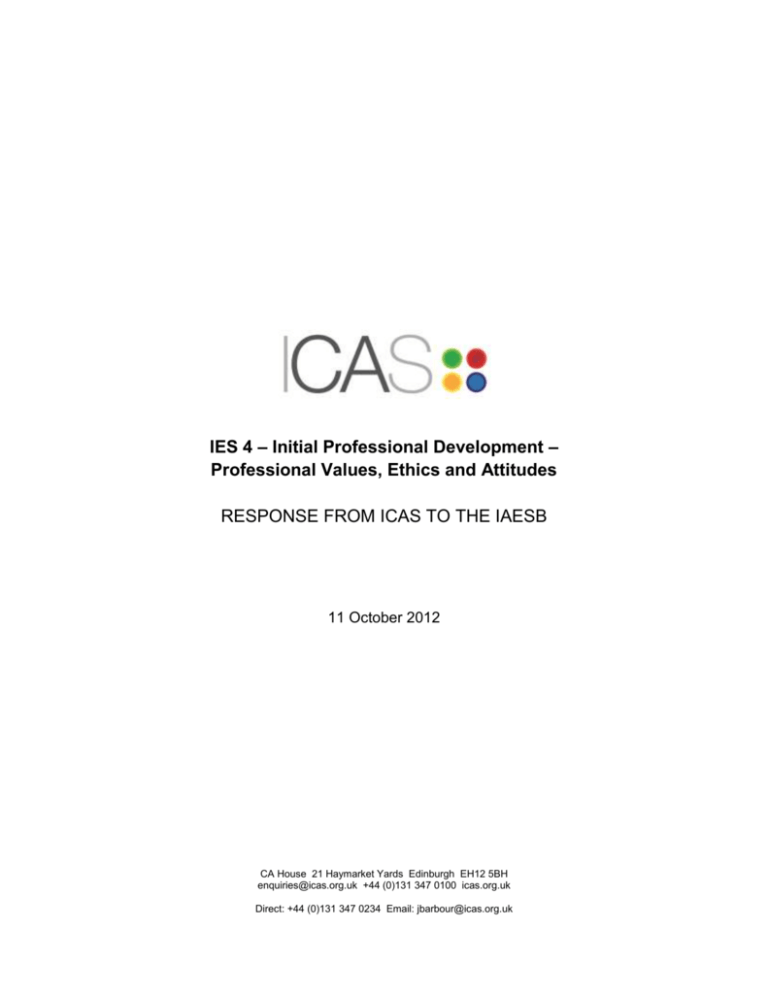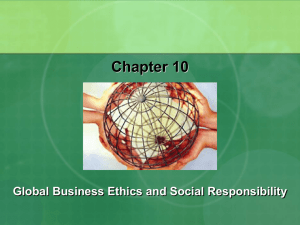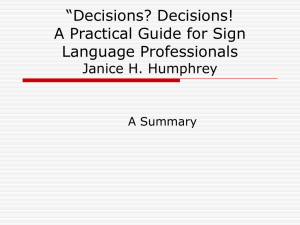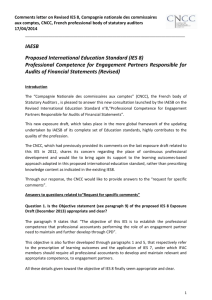Professional Values, Ethics and Attitudes
advertisement

IES 4 – Initial Professional Development – Professional Values, Ethics and Attitudes RESPONSE FROM ICAS TO THE IAESB 11 October 2012 CA House 21 Haymarket Yards Edinburgh EH12 5BH enquiries@icas.org.uk +44 (0)131 347 0100 icas.org.uk Direct: +44 (0)131 347 0234 Email: jbarbour@icas.org.uk 2 IES 4, Initial Professional Development – Professional Values, Ethics and Attitudes I refer to the above IAESB Exposure Draft and I am pleased to provide the comments of the ICAS Ethics Committee below. As the Institute’s Charter requires, the Ethics Committee must act primarily in the public interest, and responses to consultation documents etc. are predicated on the essential premise that their conclusions must be consistent with the public interest. Our Charter also requires us to represent our members’ views and protect their interests, but in the rare cases where these are at odds with the public interest, it is the public interest which must be paramount. General Comments 1. We note that much of the commentary that was contained in the previous Exposure Draft of IES 4 (particularly paragraphs 2 to 10) has been deleted. The deletion of this earlier material dilutes the content of the proposed revised standard. We would therefore urge IAESB to reinstate the commentary originally included that puts into context why ethics is absolutely core to the accountancy profession. 2. We support the new requirement for IFAC member bodies to regularly review and update professional accounting education programs that are designed to achieve the learning outcomes. 3. The content of paragraph A19 on page 17 is fine provided that the workplace is indeed ethical. Recent events at a number of organisations have highlighted that a number of such entities still have work to do in this regard. 4. We question whether the messages contained in this proposed revised IES are capable of being effectively and consistently implemented in practice in a range of different countries. Responses to specific questions Question 1: Do you agree with the tabular format adopted for learning outcomes? Yes, the tabular format provides clear learning outcomes required from aspiring professional accountants by the end of IPD. However, we do not fully agree with the proposed content. Question 2: Do you agree with the competence areas identified for ethics education? We broadly agree with the competence areas identified. However, we question the order of these proposed competences. It seems more appropriate to place (b) ethical principles first in Table A, rather than the learning outcome on professional scepticism and professional judgement. It could also be argued that (a) professional scepticism and professional judgement, should be listed last of the three stated competences. We question whether learning outcome (iv), under competence area (b) “Ethical principles, should be wider in scope i.e. refer to “applicable standards, regulations and legal requirements” rather than restricting this to the more narrowly focussed “compliance with standards”. In relation to competence area (c) “Commitment to the public interest”, we question whether learning outcome (iv) should also refer to “the client or employer, and stakeholders (including shareholders)” in addition to those listed. 3 Question 3: Do you agree with the minimum levels of proficiency as identified for each competence area? We question why the minimum level of proficiency is stated as “intermediate” for each of the outcomes. In a subject which is at the core of a profession the minimum level should be targeted at the “advanced level.” To target the level “intermediate”, which is only the second out of a possible four categories, does not place sufficient emphasis on the importance of ethics to the accountancy profession. To merely set the minimum proficiency level at “intermediate” level does not send the right message to either the profession or the world at large. Using Appendix 1 as a guide to proficiency levels, each learning outcome falls into different proficiency levels, with “explain” falling into the foundation levels, “apply” being intermediate and “evaluate” being in the advanced level. Following on from our comments above, the learning outcomes should follow a progression with one learning outcome in each competency area falling within the advanced level. Table A, either needs to be clarified to explain that the minimum proficiency level refers to the achievement of the collective learning outcomes within each competence area, or a different proficiency level included for each learning outcome. The verbs used in the learning outcomes are not consistent with the Appendix 1 guide, which may result in confusion in implementation of the standard. For example, in learning outcome (b) (iii), the aspiring professional accountant must be able to apply principles and determine an appropriate solution. Using a verb from Appendix 1 would make it clear which proficiency level this learning outcome fell within. We question the clarity of learning outcome (iv) under the Ethical Principles competence area, as “professional behaviour “is one of the relevant ethical requirements. Therefore, how can this ethical requirement be applied to professional behaviour? Learning outcomes (i) and (ii) under competence area (c) seem inconsistent. We question why good governance and social responsibility is not applicable for the role of ethics on both the profession and business and whether, indeed, these are actually separate learning outcomes. We question whether the wording of learning outcomes (iii) and (iv) under competence area (c) are sufficiently clear. Is “analyse” the appropriate verb to use for learning outcome (iii)? It is not clear what is expected of the aspiring professional accountant. Also learning outcome (iv) requires a comparison of consequences. This does not appear to go far enough, as we should expect aspiring professional accountants to evaluate the consequences of behaviour to enable them to make a decision on what action(s) to take. Question 4: Do you agree that the learning outcomes related to professional scepticism and professional judgment identified are appropriate for ethics education? Yes, these learning outcomes are appropriate for ethics education. However, we question whether the first proposed learning outcome for “professional scepticism and professional judgement” as worded, is too narrow in scope. Restricting the assessment to “financial information”, seems short-sighted given the current direction of corporate reporting in general as we move more towards corporate reports of an integrated nature. It also restricts the application of this learning outcome to financial information, which is not relevant to all ethical dilemmas that a professional accountant may be faced with, in his particular role. We note the inclusion of the wording “other data relevant to the role of a professional accountant” but still believe that the scope could be better expressed as “data” cannot properly convey what we are referring to. The “learning outcome” could be reworded as follows to reduce the focus on financial information: “Apply a sceptical mindset to critically assess information and data relevant to the role of a professional accountant.” As currently worded there is an assumption that data is information – this is not normally assumed. 4 Additionally, in part (ii) of this competence area, we question whether the word “facts” should be replaced by “information” e.g. when assessing the value of an exotic financial instrument, will there actually be “facts” available, or merely “a range of subjective estimates” produced by mathematical models. In competence area (a), we also believe that learning outcomes should be included to the effect of: 1. 2. 3. The ability to identify an ethical dilemma. The ability to know how to appropriately deal with such a dilemma. The ability to assess whether you have all the necessary information to enable you to make an informed decision. There may also be some linkage with the IESBA Exposure Draft on responding to a suspected illegal act. Therefore, there may be a need to highlight this in relation to the public interest competence area (Learning outcome (iii) of competence area (c). Question 5: Does appendix 1 of the proposed IES 4 Exposure Draft (June 2012) provide adequate clarification to assist in the interpretation of the learning outcomes that are listed in Paragraph 11 of the proposed IES 4 Exposure Draft (June 2012)? If not, what changes do you suggest? We question the language used. For example, learning outcomes will focus on the ability to: “defining, explaining, summarising”. This should read as define, explain, summarise etc. It does not currently read correctly. As noted above, examples of verbs are provided under each level of proficiency. Used consistently this can help clarify the expected learning outcomes. However, inconsistent verbs are used in the learning outcomes in table A and it may not be clear which level of proficiency each learning outcome is meant to achieve. Question 6: Are there any terms within the proposed IES 4 Exposure Draft (June 2012) which require further clarification? If so, please explain the nature of the deficiencies? Whilst the content of A2 and A3 is a step in the right direction, a more comprehensive definition of ethics would be beneficial, as “ethics” means different things to different people. Furthermore, values, ethics and attitudes are often defined separately as they are quite distinct. It may therefore be worthwhile defining each of these separately before defining the term as a whole. We question whether A2 should define “professional values, ethics, and attitudes as the professional behaviour and characteristics…” Professional behaviour is one of the fundamental principles in the Code of Ethics which is the reference in determining appropriate actions. We suggest just referring to the behaviour and characteristics that identify professional accountants. We question the proposal to adopt the IAASB’s definitions of “professional judgement” and “professional scepticism”. These definitions are biased towards audit and other assurance services. We note the paragraph below the table containing the defined terms, which effectively widens the scope of the above definitions but on balance, we believe it would be better to widen the scope of the definitions themselves. Question 7: Do you anticipate any impact or implications for your organisation, or organisations with which you are familiar, in implementing the new requirements included in this proposed IES 4 Exposure Draft (June 2012)? We do not anticipate any substantial impact on ICAS in relation to implementing the new proposed requirements. However, we would urge the IAESB to take account of our comments above. 5 Other Specific Comments 1. We question why in the IAESB Glossary of Terms on page 9, “Relevant ethical requirements” is restricted to Part A of the IESBA Code. Is this because Parts B and C are targeted at members in practice and business respectively? 2. The definition of “professional competence” also contained in the Glossary of Terms refers to “The ability to perform a role to a defined standard”. The term “defined standard” is rather cold in relation to the context of ethics. This point also applies to the definition of “technical competence” contained in the Glossary of Terms. 3. We believe that the wording objective contained in paragraph 8 on page 12, could be improved i.e. “The objective of an IFAC member body is to provide aspiring professional accountants with the professional values, ethics, and attitudes required to perform a role of a professional accountant.” Use of the word “provide” does not properly convey what is required and we suggest that the phrase “develop within” is used instead. This emphasises the important need for self-reflection in this process and also that an individual’s values and attitudes will be influenced by other factors. 4. In paragraph 9 on page 12, a “closed bracket” is required after (b. Also, inclusion of the phrase “that is in the public interest” is superfluous”, as “ethics” should not be at odds with the “public interest”. 5. On page 16, in relation to A11, we believe that the second sentence could be deleted and the content of A12 also deleted. These are viewed as superfluous in the context as the public interest point has already been made in the first sentence of A11. 6. We question the content of A13 on page 16 and its focus on the functioning of markets. The market is not always right and therefore this point is not relevant to the revised standard. 7. We support the wording of paragraph A23 but question how this would work in practice for those aspiring professional accountants who are based in parts of the world where they are training via distance learning programmes. Who will act as their respective mentors?









